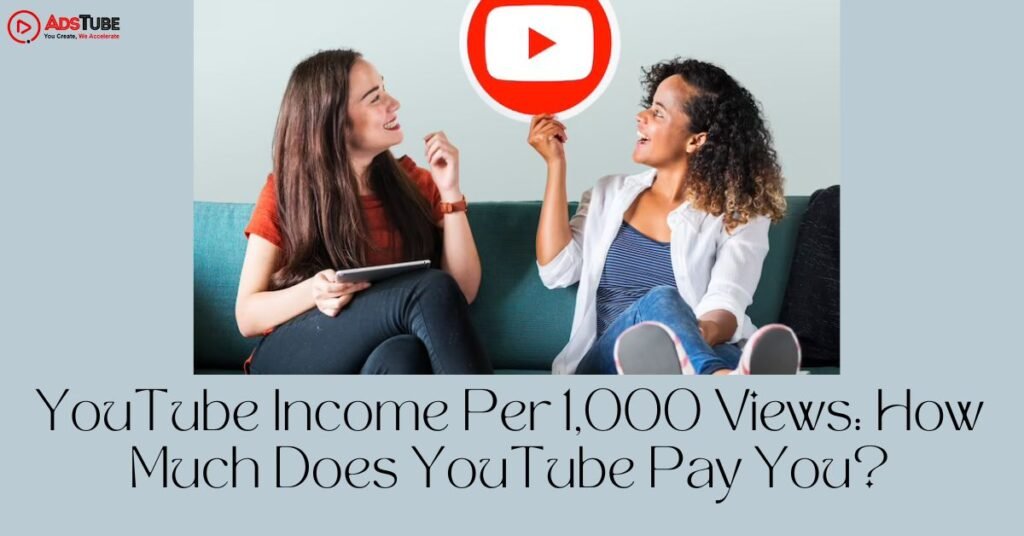In the digital age YouTube has emerged as a powerful platform that has not only revolutionized the way we consume content but has also provided opportunities for individuals to turn their interests and passions into profitable businesses. One of the most common questions among aspiring YouTubers is “How much YouTube income per 1000 views?” and people also search for “YouTube Earnings Per 1000 Views”.
The answer to this question is far from straightforward as YouTube’s monetization system is complex and influenced by various factors. In this article we will be telling YouTube’s income structure and explore how content creators can maximize their earnings.
The Basics of YouTube Monetization
Before we delve into the details of YouTube income per 1000 views let’s establish a fundamental understanding of how monetization on the platform works.
Eligibility for Monetization: To start making money on YouTube creators must meet certain eligibility criteria. These typically include having at least 1000 subscribers and 4000 watch hours in the past 12 months. Once these milestones are reached creators can apply for the YouTube Partner Program (YPP).
Ad Revenue: The primary source of income for most YouTubers, often referred to as YouTube Income Per 1000 Views, comes from ads displayed on their videos. Google AdSense is the tool through which YouTube manages ad revenue. Advertisers pay YouTube to display their ads and YouTube shares a portion of that revenue with content creators. The specific amount a creator earns from ads depends on several factors including the type of ads viewer engagement and niche.
Ad Formats: YouTube offers various ad formats each with different earning potential:
Display Ads: These are the banner ads that appear at the bottom of a video while it’s playing. They typically generate lower revenue.
Overlay Ads: These semi-transparent ads appear at the bottom of the video. Like display ads they tend to have lower earnings.
Skippable Video Ads: These are the ads that play before during or after a video. Creators earn money when viewers watch at least 30 seconds of the ad or the entire ad whichever is shorter.
Non-Skippable Video Ads: These ads are shorter (15 seconds) and cannot be skipped. Creators earn a share of the revenue from these ads but viewer engagement is crucial.
Bumper Ads: These are short non-skippable ads of up to 6 seconds. A part of the profits from these adverts goes to the creators.
CPM and RPM: Two key metrics in understanding YouTube income per 1000 views are CPM (Cost Per Mille) and RPM (Revenue Per Mile). CPM represents how much advertisers are willing to pay per 1000 views of their ads while RPM reflects the revenue generated by the creator per 1000 video views. These figures can vary widely based on factors such as content niche audience demographics and ad performance.

Factors Influencing YouTube Income Per 1000 Views
The income a YouTuber income per 1000 views is not set in stone and can fluctuate significantly. Several factors influence these earnings:
Content Niche: Different niches have varying levels of advertiser demand and competition. For example content related to finance technology and business tends to have higher CPMs because advertisers are willing to pay more for these audiences. Conversely niches like vlogs or gaming may have lower CPMs due to saturation.
Audience Location: The geographic location of a creator’s audience, a key factor influencing their YouTube Income Per Views (CPM), plays a pivotal role in their earnings. Advertisers may pay more for viewers from countries with higher purchasing power, resulting in higher CPMs for creators with a substantial international following.
Viewer Engagement: Creators who keep viewers engaged and encourage them to watch ads are likely to earn more. Longer watch times higher click-through rates and increased viewer interaction can boost ad revenue.
Ad Blockers: Some viewers use ad blockers which prevent ads from being displayed. This can significantly reduce a creator’s potential earnings.
Video Length and Type: Longer videos generally offer more ad opportunities and therefore greater revenue potential. Additionally certain video types such as tutorials or product reviews may attract more valuable ads and higher CPMs.
Seasonal Trends: Advertisers often allocate more budget for advertising during certain seasons or events such as the holiday season or major sporting events. Creators may see fluctuations in their income during these periods.
Video Quality: High-quality videos with professional production values tend to attract more viewers and advertisers. This can result in higher CPMs and overall YouTube income per views.
Ad Placement: Creators have some control over where ads appear in their videos. Placing ads strategically such as at natural breaks in the content can optimize revenue.
Subscriber and Viewer Growth: As a channel grows and gains more subscribers and views its potential for earning increases. Creators with larger audiences often attract higher-paying advertisers.
YouTube Premium and YouTube Red: YouTube Premium and YouTube Red are subscription services that offer an ad-free experience. Creators earn a portion of the subscription revenue based on how much Premium members watch their content.
Realistic Earnings: A Case Study
To provide a clearer picture of YouTube income per 1000 views let’s consider a hypothetical case study. Keep in mind that these numbers are approximate and can vary widely:
Content Creator: Sarah a beauty and lifestyle YouTuber with 500000 subscribers and an average of 100000 views per video.
Content Type: Sarah creates beauty tutorials and product reviews attracting a predominantly female audience.
CPM: Sarah’s CPM is $5 which means she earns $5 for every 1000 ad views.
RPM: Sarah’s RPM is approximately $2.50 reflecting her earnings per 1000 video views (including non-monetized views).
Monthly Views: With four videos per month Sarah accumulates 400000 views monthly.
Ad Revenue: Sarah’s estimated monthly ad revenue can be calculated as follows:
Monthly Views (400 000) ÷ 1 000 = 400 (in thousands)
Ad Revenue = CPM ($5) × Monthly Views (400 000) ÷ 1000 = $2000
This case study demonstrates that Sarah earns $2000 from ad revenue for every 400000 views which equates to a $5 RPM. However it’s crucial to remember that this is just one example and actual earnings can differ significantly based on the factors mentioned earlier.
Maximizing YouTube Earnings
While the YouTube income per 1000 views largely depends on external factors like CPM there are several strategies creators can employ to maximize their earnings:
Diversify Income Streams: Don’t rely solely on ad revenue. Explore additional income streams such as merchandise sales affiliate marketing sponsorships and crowdfunding through platforms like Patreon.
Optimize SEO: Use relevant keywords, tags, and descriptions to improve your video’s discoverability in search results and boost your YouTube income per views. This can lead to more views and higher earnings.
Engage Your Audience: Foster a community by responding to comments asking for feedback and interacting with your audience on social media
YouTube Earnings Per 1000 Views: Understanding CPM (Cost Per 1000 Views)
YouTube Earnings Per 1000 Views, known as CPM (Cost Per Mile), varies widely. It can range from a few dollars to over $10. CPM depends on factors like your video’s topic, viewer demographics, and advertiser demand. YouTube typically takes about 45% of ad revenue, leaving the creator with the rest.
YouTube Earnings Per 1000 Views and more, create engaging content, keep viewers watching longer, and place ads strategically. Diversifying income sources, such as merchandise and sponsorships, can also boost your earnings beyond ads.












